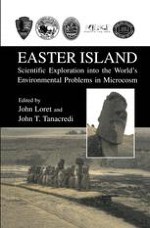2003 | OriginalPaper | Buchkapitel
Prehistoric Destruction of the Primeval Soils and Vegetation of Rapa Nui (Isla de Pascua, Easter Island)
verfasst von : D. Mann, J. Chase, J. Edwards, W. Beck, R. Reanier, M. Mass
Erschienen in: Easter Island
Verlag: Springer US
Enthalten in: Professional Book Archive
Aktivieren Sie unsere intelligente Suche, um passende Fachinhalte oder Patente zu finden.
Wählen Sie Textabschnitte aus um mit Künstlicher Intelligenz passenden Patente zu finden. powered by
Markieren Sie Textabschnitte, um KI-gestützt weitere passende Inhalte zu finden. powered by
Traditional knowledge and the earliest archaeological 14C date suggest that people arrived on Rapa Nui as early as A.D. 400 (Smith, 1961; Heyerdahl and Ferndon, 1961; Ayers, 1971; Bahn and Flenley, 1992). Prior to human arrival, much of the island was probably forested, with the largest trees a now-extinct species of palm (Flenley et al., 1991). Between A.D. 1000 and 1700, the Rapa Nui people erected megalithic sculpture, may have used a written language, and possibly numbered > 10,000 people (Bahn, 1993). However, when James Cook visited Rapa Nui in 1774, he found only several thousand people eking out a living amidst ruins on an island barren of trees. In a hypothesis originated by Mulloy (1970) and fully developed by Flenley and King (1984), Flenley et al (1991), and Bahn and Flenley (1992), uncontrolled population growth destroyed the natural vegetation, degraded the island’s ecosystems, and eventually led to the near extinction of the human population. This putative ecological history of Easter Island is cited as support for predictive models for the human use of natural resources (Brander and Taylor, 1998) and has passed into the modern folklore embodied by popular cinema. Accepting that Rapa Nui is a microcosm for the planet Earth, the “Lost Eden” interpretation of its history paints a grim picture of our collective future (Bahn and Flenley, 1992). On the other hand, the paleoecological data that describes the ecological history of Rupa Nui is far from complete (Orlic and Orliac, 1998; Nunn, 2000).
